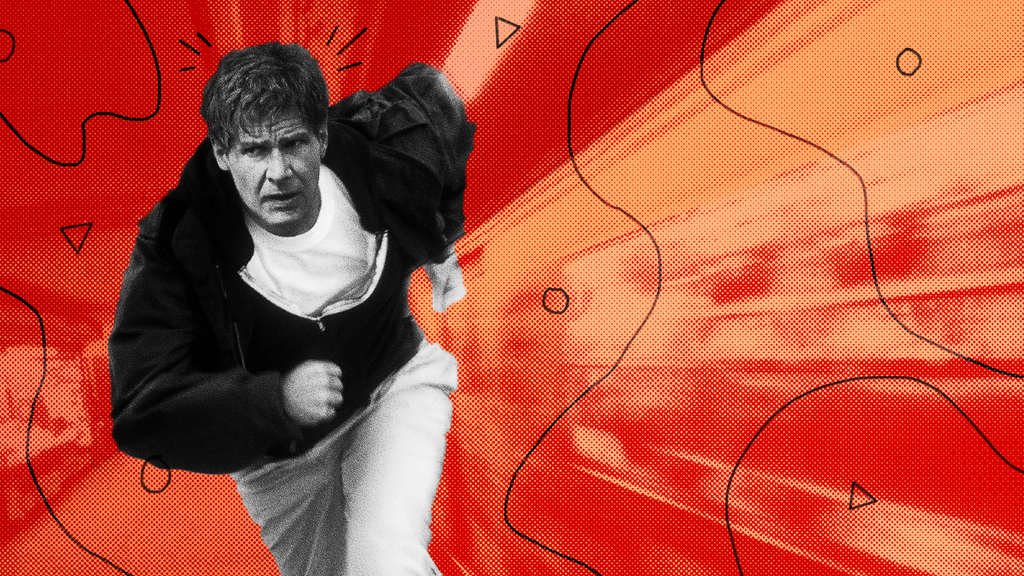Storyclock Research Log
The Fugitive
By Seth Worley

This week in the Research Log, we're clocking 1993's THE FUGITIVE. As usual, we've watched the movie and used the Storyclock Notebook to visualize the film's structure in the form of a clock. Let's dive in (and totally survive) like Dr. Kimble as we analyze this movie's efficient and urgent pace, complete lack of subplots, and more.
Let's Break It Down
- Opening Image: Super 90's-style murder flashbacks establishing Kimble's wife has been murdered. Emphasis on the "has" -- this is not a movie about a woman being murdered. It's a movie about a husband whose wife *has been* murdered. Her murder is the situation, the condition in which we find the hero, who is now being put into a police car and driven away while an unseen news anchor kindly tells us everything we need to know.
- Normalcy: The normalcy for this story is that Richard Kimble in prison. If nothing happened to disrupt that normalcy, he would be in prison for the rest of the movie.
- Normalcy Disrupted: But something does happen. The other prisoners on his bus stage an escape, causing the bus to crash and roll onto a railroad, where a train happens to be coming through town at that exact moment.
- Rational Approach: Kimble runs. Fixes himself up. Tries to stay under the radar. But Sam Gerard arrives and isn't going to stop until he's found Kimble.
- Acceptance and Break Into Act 2: Kimble's point of no return: he jumps off a waterfall and survives because movies. I'm claiming this as the break into Act 2 because it's the first time Kimble makes a conscious decision to continue forward and do the irrational thing.
- Act 2 Story Begins: Kimble dreams about himself screaming FIND THAT MAN. He wakes up, determined to FIND THAT MAN.
- Midpoint/Arrival at Solution: Kimble has another dream about prosthetic arms, likely because he's been studying them like crazy and because the audience may have forgotten that this is what he's been working on. He goes to the hospital and finally prints out a list of possible THAT MAN's for him to FIND.
- Things Get Worse: Kimble goes to meet the first possible person on his list: Clive Driscoll. But Clive isn't THAT MAN.
- Breakthrough and Rebirth/Break Into Act 3: Kimble breaks into Sykes's house and finds pictures of Red Herring and ties to Devlin McGregor. He calls Gerard directly, leading the Marshals to Sykes.
- Hero Gains Upper Hand: Kimble does some digging into the Devlin McGregor drugs and discovers to the real Badguy is.
- Shadow's Final Push: Kimble confronts Badguy. Badguy responds by starting an all-out wrestling fight with him that travels to the roof, then to an elevator shaft, then to the laundry floor.
- Ultimate Breakthrough: Gerard tells Kimble that he knows he's innocent.
- New Normalcy: Kimble isn't a criminal anymore. He's proven his innocence and exposed the real Badguy.
- Final Image: Gerard puts Kimble into a police car, removes his cuffs, and they're driven away.
Stuff That Stood Out To Me
- The first act is long, but good Lord it moves like a mother****er. Within the first fifteen minutes, we're introduced to Richard Kimble, we establish that his wife has just been murdered, he's questioned, convicted, tried, sentenced, put on a bus, thrown into the middle of an attempted prison break, and thrown in front of a moving train. IN THE FIRST FIFTEEN MINUTES.
- Two big things that help make this movie so engaging:
- Richard Kimble’s profession. As a doctor, he knows how to give himself a tetanus shot, tip off the EMT’s on the prison guard’s injuries, etc. Audiences like characters who are good at their jobs.
- Sam Gerard — the supposed antagonist — is so. damn. likeable. And equally good at his job.
- Another thing this movie is great at is sequencing.
- Kimble gets convicted.
- Kimble gets freed.
- Kimble gets chased.
- Kimble gets smarter so he can FIND THAT MAN.
- Kimble gets a list of possible THAT MANs and sets out to FIND THAT MAN.
- etc
- There are no subplots in this movie. There's almost one, but Gerard shoots him.
- In accordance with the rules of storytelling, they totally broadcast the Badguy in the first act. But they disguise it by introducing the Red Herring in the same scene. Good trick to remember.
- Symmetrical Moments: The movie opens with Kimble being put into a police car + ends with Kimble being put into a police car.
- Symmetrical Moments: Badguy gives Kimble his keys back at the gala + Gerard tells Kimble he knows Badguy borrowed his car the night of the murder so he had the keys to his house, and called Sykes from his car phone.
- Symmetrical Moments: Gerard tells Kimble, "I don't care" + Kimble phones Gerard from Sykes's house and calls back to that moment.
- Symmetrical Moments: Kimble dreams about himself yelling "FIND THAT MAN" + Kimble FINDS THAT MAN
- Symmetrical Moments: Gerard shoots Copeland, telling Newman, "I don't bargain" + Gerard straight up shoots Kimble (not knowing the glass separating them is bulletproof)
Lastly, there's not a lot we could say about THE FUGITIVE that this excellent article from The Atlantic didn't already say. Particularly this part, in regards to the film's pacing:
For two hours and 10 minutes, this film does not relent. Not even for a cup of coffee (that scene was cut), not even for some shopping (cut), not even for romance (also cut)... And the urgency is a good thing because every pause introduces a new threat—a passing cop, a skeptical doctor, a nosy guard... As Matt Zoller Seitz wrote of The Fugitive on rogerebert.com last year, “The multilayered, at times prismatic way that it delivers information feels like an evolutionary leap forward for thrillers.”
"A leap forward for thrillers," and yet, sadly, they're aren't a lot of movies like this these days. Maybe it's time someone wrote one?




